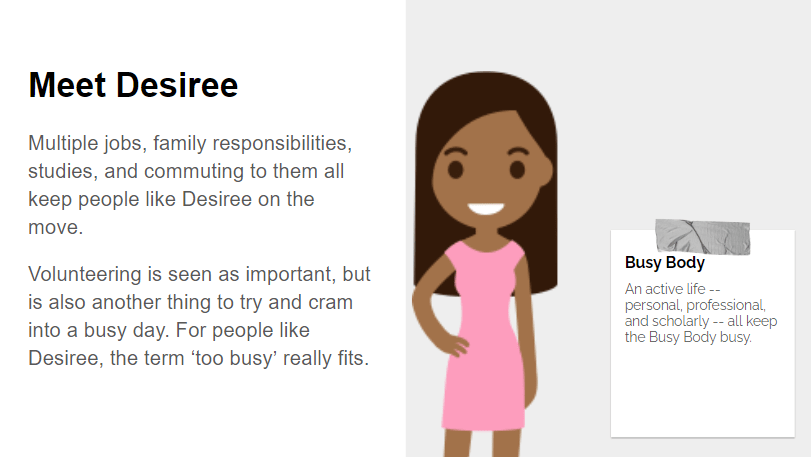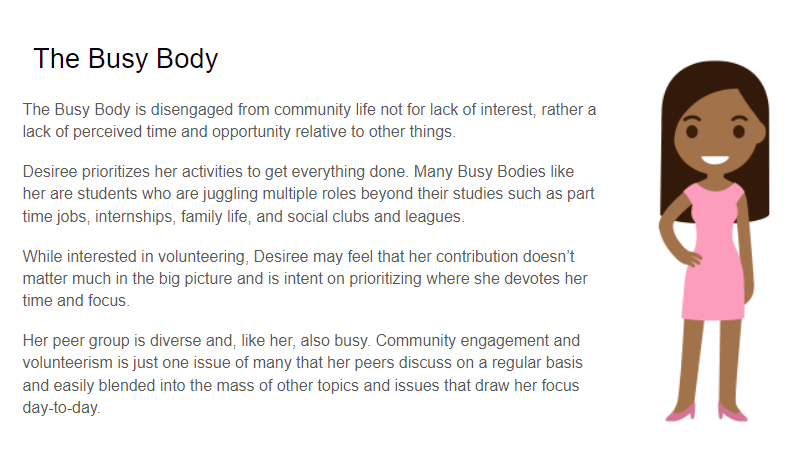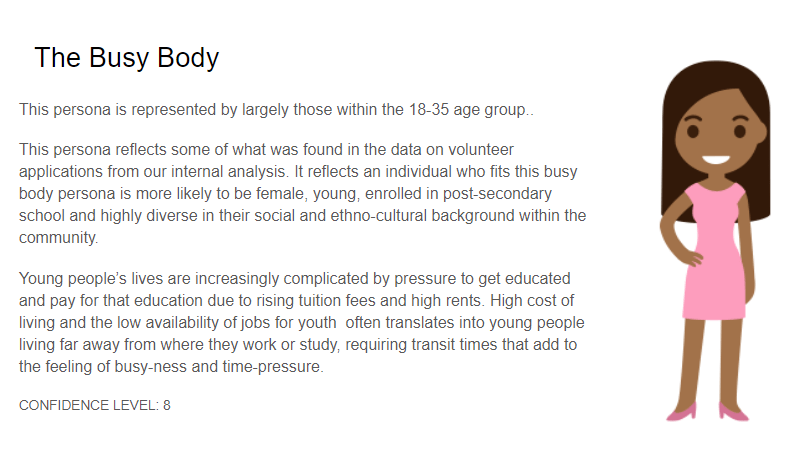This is an Eval Central archive copy, find the original at cense.ca.

When we design any service or product we are creating it with someone in mind. Personas are a design-oriented approach that can enable us to envision this ‘someone’ – our markets – to better design our products and services for them.
Whether it is a new software product, a grant-making project, a collaborative initiative, or a social policy — any product or service is designed for some person(s) and groups. The more we can anticipate what the needs, wants, and preferences are of this group and how they live, work, and play — the better fit we’ll have.
Personas are a visual way to develop hypotheses and insight into what our customers, clients, and audiences might think, act, and use .
Personas: Qualities
Personas provide evidence-based insights that help us reframe
challenges by creating caricatures that are rooted in data and observations and can provide us with a means to anticipate how or why these individuals might engage with our products and services.
• Personas are not just descriptions of what we already believe about our audience. They come from the perspectives of our actual users. They may challenge or differ from the usual categories we rely on to think about our users.
• Each persona represents a group of users with similar characteristics,
habits, needs, and/or goals. Demographics may or may not play a key
part in a persona.
• Users also differ in important ways from each other; personas highlight
differences that matter.
• Personas are formed by bringing together multiple sources of
quantitative and qualitative data from diverse internal and outside
sources. If the data is not available, then design research is recommended to gather what’s required to make informed decisions.
This might include: surveys, published research from elsewhere, government or external reports, key informant interviews, field observations and direct observation or engagement with users.
Design Steps

Personas begin by looking at the data you have available and, where necessary, gathering more data to ensure you have a reasonable sample that captures both who you believe is your primary user and those who might be potential users.
Examine patterns and look for qualities among the sample — those individuals and groups that are represented in the data — that might go together. This includes things like:
- Demographics – those that matter related to your product (e.g., age, sex, gender, race, ethnocultural heritage, income, sexual identity, education, employment)
- Personal Identifiers (e.g., lifestyle behaviours, consumption patterns)
- Experience with product or service. Are they experienced or new? What knowledge do they have or need to use it? What motivation might they have to use it?
- Aspirations. What does the product or service solve for this individual? What does it bring to them or allow them to achieve? What are their goals?
- Fears and Hopes. What are the ‘pain points’ or the things that will attract or detract users from engaging with your product?
- Skills and Knowledge. What do users know, need to know, and what skills are necessary to engage with your product or service?
Next, sketch out the user. Make them visual — a look or feel and even a name. You might find yourself coming up with many different personas and this is helpful do allow you to determine the differences that make a difference. For example, if you find that the use of your product isn’t highly influenced by a certain demographic quality then that persona isn’t as affected by what you choose on that issue.
Once your personas have been developed, it’s helpful to consult with actual users that represent those personas in some form to test or validate some of the assumptions you used to develop those personas. Personas are not representative of actual people, they are combinations of qualities so the fit doesn’t have to be perfect, just coherent. Coherence is what you’re looking for.
After this, refine and design. Take what you learn and start designing your product or service for these users.
Sample
Below is an example of what a Persona could look like. The example below is modified from a real project undertaken by Cense Ltd and uses the example of volunteerism within a particular community as the focus. It represents one of many personas that were developed as part of an understanding of the issue. In this case, there was considerable data available on users which made it possible to give a confidence score out of 10 based on how confident the team felt the persona adequately represented characteristics of actual users.
What you’ll find is that by undertaking this research and the process of envisioning your users and potential users you can create a better fit with your product, higher adoption rates, and far fewer problems down the road.
This is a highly participatory process and when combined with the best data and developmental design approach increases the learning of your organization as well as creating better, more innovative products.
Want to apply this to your work and need some help? Contact us and we can help. This is what we do.


